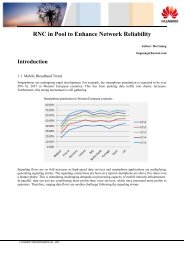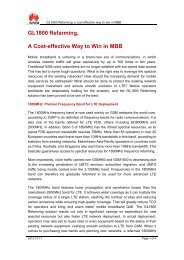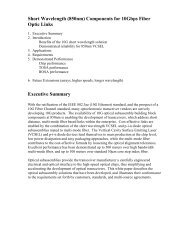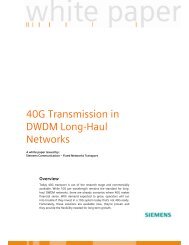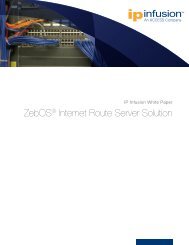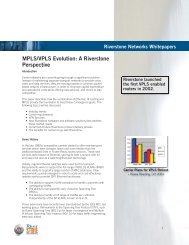Welcome to the Human Network - Light Reading
Welcome to the Human Network - Light Reading
Welcome to the Human Network - Light Reading
Create successful ePaper yourself
Turn your PDF publications into a flip-book with our unique Google optimized e-Paper software.
Mobile wireless networks are poised <strong>to</strong> become a primary vehicle for a wide<br />
variety of communications applications. Data is becoming a major force<br />
behind <strong>the</strong> mobile opera<strong>to</strong>rs’ efforts <strong>to</strong> significantly increase ARPU. Service<br />
providers are focusing on building a network that is capable of delivering<br />
a host of real-time multimedia applications in addition <strong>to</strong> supporting<br />
business-class data application and services.<br />
Extending <strong>the</strong> capabilities of <strong>the</strong> Cisco Service Exchange Framework, <strong>the</strong> Cisco IP NGN<br />
Carrier E<strong>the</strong>rnet design supports service access control, deep packet inspection, Mobile<br />
IP, security, and packet gateways for each of <strong>the</strong> major radio technologies. Packet gateway<br />
options include <strong>the</strong> Cisco Packet Data Serving Node (PDSN) for Code Division Multiple<br />
Access (CDMA), Cisco Gateway GPRS Support Node (GGSN) for Global System for Mobile<br />
Communications/Universal Mobile Telecommunications Service (GSM/UMTS), and IP<br />
Transfer Point (ITP) for offloading SS7 signaling on<strong>to</strong> IP networks. Cisco is also a leader in<br />
<strong>the</strong> development of IEEE 802.x technology <strong>to</strong> support public wireless LAN installations and<br />
Wi-Fi municipal mesh deployments in <strong>the</strong> unlicensed bands. The latter is an exciting new<br />
area that promises very high data rates in metropolitan areas using unlicensed spectrum.<br />
The next-generation mobile networks will make extensive use of both licensed and<br />
unlicensed wireless technologies. Unlicensed radio technologies provide very high<br />
performance over a limited area, whereas licensed radio technologies provide ubiqui<strong>to</strong>us<br />
connectivity across <strong>the</strong> wide area but offer less performance than is generally available from<br />
an unlicensed service. Mobile IP is <strong>the</strong> glue that can bind <strong>the</strong>m <strong>to</strong>ge<strong>the</strong>r in<strong>to</strong> a transparent<br />
service offering.<br />
Metropolitan Wi-Fi Mesh <strong>Network</strong>ing<br />
The Cisco IP NGN Carrier E<strong>the</strong>rnet design is unique in its industry-leading ability <strong>to</strong><br />
converge services over E<strong>the</strong>rnet, including metropolitan Wi-Fi mesh networking. The<br />
Wireless Services Module (WiSM), which is integrated in<strong>to</strong> <strong>the</strong> Cisco 7600 Series, offers<br />
integrated Wi-Fi access-point aggregation, enabling providers <strong>to</strong> scale and manage<br />
metropolitan Wi-Fi mesh networks. The WiSM supports <strong>Light</strong>weight Access Point<br />
Pro<strong>to</strong>col (LWAPP) while providing extensive integrated security capabilities such as Wi-Fi<br />
Protected Access (WPA2) and various types of <strong>the</strong> Extensible Au<strong>the</strong>ntication Pro<strong>to</strong>col<br />
(EAP), including Protected EAP (PEAP).<br />
The module also improves wireless security through rogue access-point detection and<br />
containment and by supporting a wireless intrusion prevention system (IPS) <strong>to</strong> provide<br />
consistent security-policy enforcement across <strong>the</strong> entire fixed and wireless network.<br />
Providers can use <strong>the</strong> WiSM <strong>to</strong> enable convergence of Wi-Fi, mobile (IP Radio Access<br />
<strong>Network</strong>, PDSN, and GGSN), and fixed (Layer 2 and 3) networks for flexible advanced<br />
service aggregation.<br />
PDSN and GGSN Integration<br />
The PDSN and GGSN packet gateway options allow service providers <strong>to</strong> reduce <strong>the</strong> costs<br />
associated with deploying and operating mobile wireless networks by consolidating<br />
<strong>the</strong> switched systems required <strong>to</strong> converge applications across multiple transport<br />
technologies (SONET, time-division multiplexing [TDM], ATM, etc.) <strong>to</strong> a single E<strong>the</strong>rnet and<br />
IP/MPLS network This integration allows providers <strong>to</strong> use lower-cost alternative access<br />
technologies such as broadband E<strong>the</strong>rnet, DSL, and IP wireless radio based on <strong>the</strong> best<br />
available cost on a market-by-market basis.<br />
Cisco IP NGN Carrier E<strong>the</strong>rnet design supports integration with PDSN and GGSN<br />
networks, enabling providers <strong>to</strong> fur<strong>the</strong>r reduce costs by using IP networks <strong>to</strong> backhaul<br />
wireline and mobile traffic, avoiding <strong>the</strong> need <strong>to</strong> build out additional capacity of costly<br />
TDM networks.







